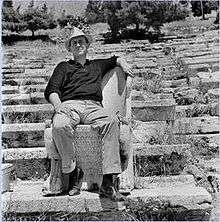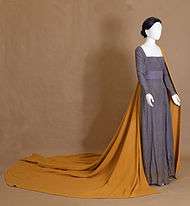Yannis Tsarouchis
Yannis Tsarouchis (Greek: Γιάννης Τσαρούχης; 13 January 1910 – 20 July 1989) was a Greek painter.
Yannis Tsarouchis | |
|---|---|
 Tsarouchis in a picture by Dimitri Papadimos | |
| Born | 13 January 1910 |
| Died | 20 July 1989 (aged 79) Athens, Greece |
| Occupation | painter |
| Signature | |
Biography
Early life
Born in Piraeus, he studied at the Athens School of Fine Arts (1929–1935). He was also a student of Photios Kontoglou, who introduced him to Byzantine iconography, while he also studied popular architecture and dressing customs. Together with Dimitris Pikionis, Kontoglou and Angeliki Hatzimichali he led the movement for the introduction of Greek tradition in painting.
From 1935 to 1936 he visited Istanbul, Paris and Italy. He came in contact with the Renaissance art and Impressionism. He discovered the works of Theophilos Hatzimihail and met influential artists such as Henri Matisse and Alberto Giacometti.
Work

He returned to Greece in 1936 and two years later he produced his first personal exhibition in Athens. He later fought in the Greco-Italian War in 1940. In 1949, he and other artists, including Nikos Hadjikyriakos-Ghikas, Yannis Moralis, Nikos Nikolaou, Nikos Engonopoulos and Panayiotis Tetsis, established the "Armos" art group. In 1951 he had exhibitions in Paris and London. In 1958 he participated in the Venice Biennale. In 1967 he moved to Paris.
He filled his canvases with images of vulnerable men and (to a much lesser extent) strong women.[1]
Sylvester & Orphanos published Yannis Tsarouchis: The Face of Modem Greece.[2]
Institutions
In 1982 the Yannis Tsarouchis Foundation Museum in Maroussi, Athens, was inaugurated. The Museum is actually hosted in the house of the artist. See also Yannis Tsarouchis Foundation Museum.
He died in Athens in 1989.
Notes
- Gianoulis, Tina (2002). "Tsarouchis, Yannis (1910-1989)". glbtq.com. Archived from the original on 2007-04-18. Retrieved 2007-06-03.
- Luckenbill, Dan (1990). Sylvester & Orphanos : catalog of an exhibit, October–December 1990. UCLA. Retrieved 13 March 2018.
References
- Adaptation of the Greek Wikipedia article.
External links
- Tsarouchis Paintings
- Tsarouchis Foundation
- Biography and selected Works (Greek only)
- Interview (Greek only)
- Documentary video and Interview
- Documerntary video with the artist